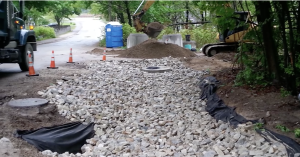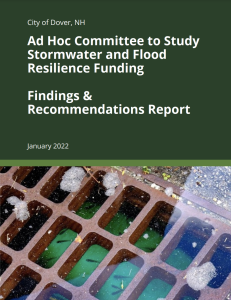By: Kyle Pimental (Strafford Regional Planning Commission) and Ben Sweeney (NHDES Coastal Program)
As a result of a collaborative effort, the City of Dover has implemented several stormwater management strategies seeking to address impacts from climate change.
In 2020, the City of Dover, in partnership with the Strafford Regional Planning Commission (SRPC), received funding through the New Hampshire Department of Environmental Services (NHDES) Coastal Program Resilience Planning Grant Program to implement several actions identified in the City’s 2018 Climate Adaptation Master Plan, including addressing extreme heat and stormwater runoff from increasing precipitation. The goal of the project was to strengthen Dover’s resilience to climate change by improving the City’s urban landscape through various mechanisms and providing education on innovative approaches to stormwater design.
The project had three components. The first was the creation of an Urban Street Tree Plan for the Central Business District, which was highlighted in the Spring 2021 CAW Newsletter, that provides a series of recommendations for future tree plantings, cost-effective structural measures for stormwater to help urban street trees thrive, and best management practices for addressing invasive species.
The second was amendments to the City’s Complete Streets and Traffic Calming Guidelines. Revisions included, but are not limited to emphasizing the connection between providing safe and accessible streets with a complete street approach that generates environmental protection and stormwater management benefits. For example, the policy states that whenever possible…
…innovative, and educational stormwater infrastructure and best management practices, such as vegetation, landscaping, and on-site stormwater treatment infrastructure, including bioswales, planters, rain gardens, and street trees, shall be designed and integrated into the construction/reconstruction or retrofit of a street. These elements not only treat stormwater, but they can also be used to create an attractive streetscape and slow vehicles speeds – which is critical for pedestrian safety.
 The final component of the project was the installation of a stormwater retrofit in the downtown core and an associated outreach campaign. According to Deputy Director of Community Services Bill Boulanger, the construction of biofiltration systems in urban cores can be difficult, and as a result he and the UNH Stormwater Center collaborated on their own design. This design, known locally as a “Boulanginator,” is a precast concrete media box filled with a mixture of organic materials, such as bark chips, sand, and residuals from the water treatment plant, that is then tied into a tree box filter to treat stormwater.
The final component of the project was the installation of a stormwater retrofit in the downtown core and an associated outreach campaign. According to Deputy Director of Community Services Bill Boulanger, the construction of biofiltration systems in urban cores can be difficult, and as a result he and the UNH Stormwater Center collaborated on their own design. This design, known locally as a “Boulanginator,” is a precast concrete media box filled with a mixture of organic materials, such as bark chips, sand, and residuals from the water treatment plant, that is then tied into a tree box filter to treat stormwater.
What makes this stormwater approach different from other systems is that it has a baffle wall and trash rack in the concrete tank that separates the filter media from a sump area. This innovative design feature ensures that all the settled materials such as sands and debris and floatables such as trash never get to the filter media. It is a low maintenance, low-cost technique that can be cleaned with just a sump along with regular catch basin maintenance program. This can easily be implemented by other communities that are trying to incorporate stormwater treatment within the built environment.
When asked for his thoughts on this project, Dover’s Resilience Coordinator Jackson Kaspari said, “the pilot tree box filter project is a great example of practical innovation. This system allows for effective biofiltration of stormwater in a way that limits detriments to the tree’s health and is low maintenance for municipal services. Resiliency is an all-encompassing concept. Building off this success, future related projects are needed to lessen our community’s impacts and thus improve our environmental resiliency. However, those projects must be carefully developed, like the tree box filter, to ensure the infrastructure and associated life-cycle are also resilient by design.”
As part of their outreach campaign, the City created and published an informative video entitled, “Tree Boxes and Stormwater Management in the Urban Core.” The video details their innovative approach to treating stormwater and providing water to trees in an urban, downtown environment. The video includes interviews with Community Services Deputy Director Bill Boulanger and Planning Resilience Coordinator Jackson Kaspari and was shared in the Dover Download and airs regularly on Channel 22.
Tackling the funding challenge
The City has highly skilled and experienced staff with an impressive history of securing grants to implement these projects, but a lack of dedicated funding can be a major impediment to local progress on stormwater management. The City’s Stormwater Program currently must compete for General Fund dollars, but many other services with broad public support take precedence for funding, which can result in deferred planning, maintenance, and capital improvements.
Therefore, the City partnered with the NHDES Coastal Program and Piscataqua Region Estuaries Partnership (PREP) to establish and support an Ad Hoc Committee to Study Stormwater and Flood Resilience Funding. In November 2020, Dover City Council created this stakeholder-led Committee of residents, business representatives, developers, non-profits, and environmental advocates to “investigate, study, and identify and make recommendations to the City Council concerning various funding opportunities that may exist with respect to existing needs and future stormwater and flood resilience planning.” The Committee’s charge allowed it to review all potential funding solutions through an exploratory, fact-finding process to identify the most equitable funding solution capable of providing adequate and sustainable funding for increasing stormwater and flood resilience costs.
During the Committee’s final meeting on January 10, 2022, members voted unanimously to approve its Final Report to the City Council that recommends pursuing a stormwater and flood resilience utility. Much like electric, water, and sewer utilities that are based on use, stormwater and flood resilience utility fees are based on the amount of impervious area on a property, which is directly related to the amount of stormwater generated from the property. The Committee believes this funding mechanism would create a more equitable, service-based distribution of costs.
What’s Next?
The Committee will present its recommendations to City Council in February 2022. If City Council accepts their recommendations, the Committee strongly encourages the City to launch a robust public outreach and input process on the development of a utility before going through the City Council’s implementation approval process.
The steps the City of Dover has taken to implement its Climate Adaptation Master Plan and secure reliable funding for on-the-ground stormwater and flood resilience projects are crucial to prepare for changing conditions. Extreme precipitation events will continue to become more frequent and threaten to overwhelm the capacity of municipal stormwater systems in the seacoast region, which could result in increased pollution to local waterbodies and public safety issues such as road closures. As such, the New Hampshire Coastal Flood Risk Summary, Part II: Guidance (2020) recommends communities plan for at least a 15% increase in extreme precipitation. By referencing the best available climate science and guidance, as well as adopting innovative approaches to stormwater management that improve resiliency, communities can save money, property, and most importantly, lives that could be at risk in the future.
